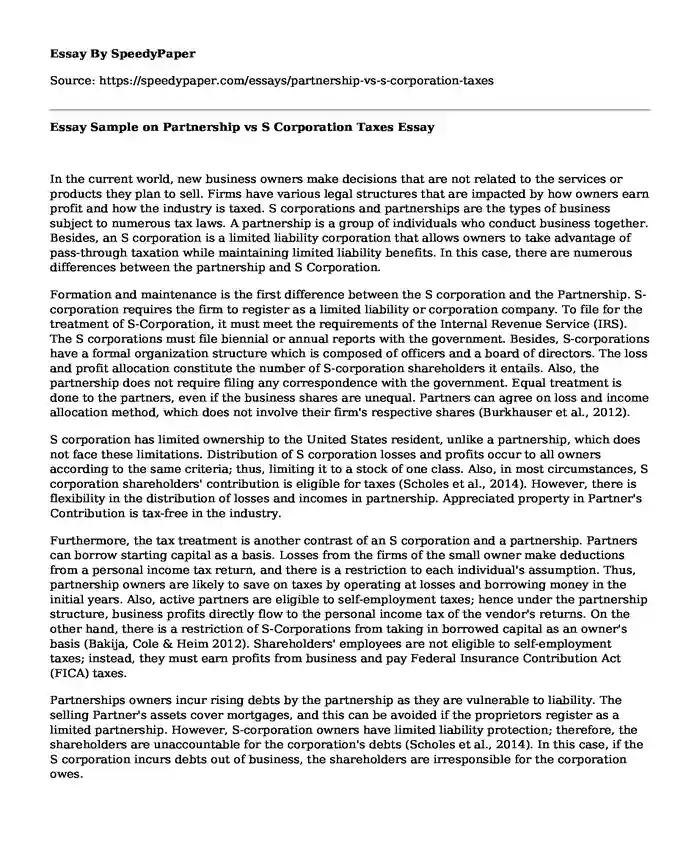
| Type of paper: | Essay |
| Categories: | Tax system Business communication |
| Pages: | 3 |
| Wordcount: | 650 words |
In the current world, new business owners make decisions that are not related to the services or products they plan to sell. Firms have various legal structures that are impacted by how owners earn profit and how the industry is taxed. S corporations and partnerships are the types of business subject to numerous tax laws. A partnership is a group of individuals who conduct business together. Besides, an S corporation is a limited liability corporation that allows owners to take advantage of pass-through taxation while maintaining limited liability benefits. In this case, there are numerous differences between the partnership and S Corporation.
Formation and maintenance is the first difference between the S corporation and the Partnership. S-corporation requires the firm to register as a limited liability or corporation company. To file for the treatment of S-Corporation, it must meet the requirements of the Internal Revenue Service (IRS). The S corporations must file biennial or annual reports with the government. Besides, S-corporations have a formal organization structure which is composed of officers and a board of directors. The loss and profit allocation constitute the number of S-corporation shareholders it entails. Also, the partnership does not require filing any correspondence with the government. Equal treatment is done to the partners, even if the business shares are unequal. Partners can agree on loss and income allocation method, which does not involve their firm's respective shares (Burkhauser et al., 2012).
S corporation has limited ownership to the United States resident, unlike a partnership, which does not face these limitations. Distribution of S corporation losses and profits occur to all owners according to the same criteria; thus, limiting it to a stock of one class. Also, in most circumstances, S corporation shareholders' contribution is eligible for taxes (Scholes et al., 2014). However, there is flexibility in the distribution of losses and incomes in partnership. Appreciated property in Partner's Contribution is tax-free in the industry.
Furthermore, the tax treatment is another contrast of an S corporation and a partnership. Partners can borrow starting capital as a basis. Losses from the firms of the small owner make deductions from a personal income tax return, and there is a restriction to each individual's assumption. Thus, partnership owners are likely to save on taxes by operating at losses and borrowing money in the initial years. Also, active partners are eligible to self-employment taxes; hence under the partnership structure, business profits directly flow to the personal income tax of the vendor's returns. On the other hand, there is a restriction of S-Corporations from taking in borrowed capital as an owner's basis (Bakija, Cole & Heim 2012). Shareholders' employees are not eligible to self-employment taxes; instead, they must earn profits from business and pay Federal Insurance Contribution Act (FICA) taxes.
Partnerships owners incur rising debts by the partnership as they are vulnerable to liability. The selling Partner's assets cover mortgages, and this can be avoided if the proprietors register as a limited partnership. However, S-corporation owners have limited liability protection; therefore, the shareholders are unaccountable for the corporation's debts (Scholes et al., 2014). In this case, if the S corporation incurs debts out of business, the shareholders are irresponsible for the corporation owes.
In conclusion, most businesses are set up as partnerships as it offers more flexibility than S corporation in the tax treatment. Nevertheless, the shareholders of an S corporation have limited legal liability while partners are uninsulated from the partnership's liabilities and debts.
References
Bakija, J., Cole, A., & Heim, B. T. (2012). Jobs and income growth of top earners and the causes of changing income inequality: Evidence from US tax return data.
Burkhauser, R. V., Feng, S., Jenkins, S. P., & Larrimore, J. (2012). Recent trends in top income shares in the United States: reconciling estimates from March CPS and IRS tax return data. Review of Economics and Statistics, 94(2), 371-388.
Scholes, M. S., Wolfson, M. A., Erickson, M., Maydew, E., & Shevlin, T. (2014). Taxes & business strategy. Upper Saddle River, NJ: Prentice-Hall.
Cite this page
Essay Sample on Partnership vs S Corporation Taxes. (2023, Mar 27). Retrieved from https://speedypaper.net/essays/partnership-vs-s-corporation-taxes
Request Removal
If you are the original author of this essay and no longer wish to have it published on the SpeedyPaper website, please click below to request its removal:
- Abortion Essay Sample
- Weathering Essay Example
- Environmental Essay Example on Minimizing Industrial Pollution
- A Comparative Essay Example on Modernist and Romantic Eras
- Essay Example. French Empire's Religious Legacy and Its Influence on Contemporary Transnational Relations
- Free Essay. International Migration and Social Theory by Karen O'reilly
- Paper Example: Freshettes, Farmerettes, and Feminine Fortitude
Popular categories




